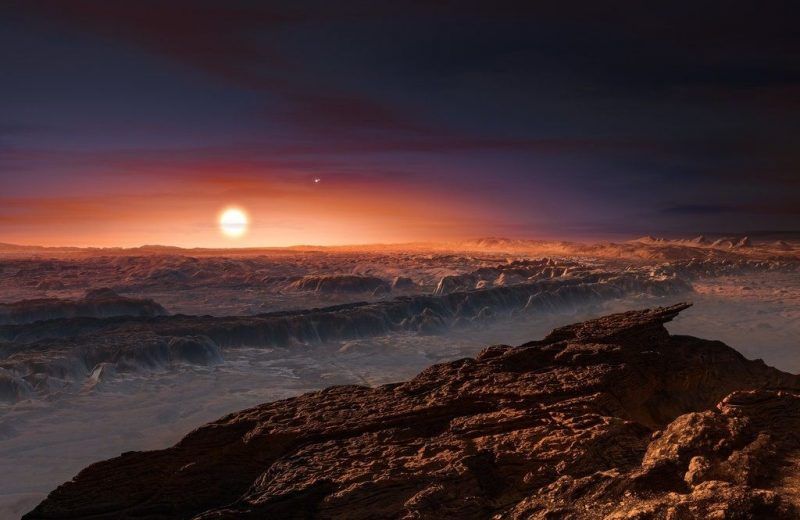
Yesterday, the European Southern Observatory announced that astronomers have detected a planet the size of Earth orbiting our nearest star, Proxima Centauri. We discover hundreds of “exoplanets” every year, but this one is different: It orbits its star at just the right distance so that, in theory, it’s possible it could sustain life. This detection of a “goldilocks” planet so close to our own marks a significant achievement for exoplanet astronomy, the young field devoted to the search for and study of planets orbiting stars other than our sun.
The European Southern Observatory’s news release explains that Proxima Centauri, unlike the other two stars in its system, is a red dwarf, smaller and cooler than our sun. Although liquid water, that all-important life sustaining substance, might exist on the surface of this planet, its 11-day orbit and strong radiation would create a climate very different from Earth’s. Standing on the surface, one would see not the familiar blue sky; more likely, it would be an alien red.
The astronomers are of course well aware of these dissimilarities. Why, then, do they still insist on categorizing this planet as Earthlike? Some fantasize that “another earth” could be a celestial refuge if we end up destroying our own. Another answer is that detecting a planet like ours capable of hosting life brings us one step closer to answering the ultimate question of whether or not we are alone in the universe — the end of our “cosmic loneliness,” as the science reporter Dennis Overbye wrote in this paper.
But today’s announcement will not readily lead to contact with an intelligent alien. This discovery, more than offering a connection between life-forms, is much more about us connecting with what Earth is, as a place and as our home.
Exoplanet astronomy flourished with the 2009 launch of Kepler, a space telescope dedicated to finding exoplanets. At the time, I was a graduate student at MIT studying the anthropology and history of science, in particular the men and women studying planets as close as Mars and as distant as the exoplanets Kepler was rapidly finding. What drove them? Exoplanets are rather insignificant astronomical objects, but I learned how these scientists transformed planets into places and in so doing have populated the cosmos with hundreds of meaningful worlds.
In this community, the ideal is the Earthlike exoplanet. As an exoplanet graduate student once told me, “In the end, we want to find other Earths. We want to find something similar to us.”
In 2008, a group of astronomers reflected on the philosophical implications of such a discovery, writing that it would tempt us “with wild dreams of flight,” and we would “refocus our energies to hasten the day when our descendants might dare to try to bridge the gulf between two inhabited worlds.” The cover of the current issue of New Scientist offers a beautiful, welcoming artist’s rendering of the newly discovered planet orbiting Proxima Centauri. “We’ve found an Earthlike planet around our nearest star,” the cover asks. “Should we go there?”
Dreams of interstellar journeys or contacting alien life overshadow a less sensational but equally meaningful aspect of this discovery: Amid all of the fantastical configurations in the universe, we most desire to connect with a rather unremarkable ball of rock, ice and gas, for the simple but powerful reason that it reminds us of our home. To even claim the existence of an Earthlike planet is also to claim, rightly or wrongly, that we know and understand our planet. Despite a changing climate and an unsettled population, there is some essence of our planet that we can recognize and point to, saying, “that is us.”
When I spoke with astronomers about methods for detecting Earth’s twin, I was struck that what they were searching for was Earth at its most pristine. One reason the search for an Earthlike planet is so compelling is that it is unexpectedly nostalgic. It propagates an imagination of Earth as an ideal, edenic home. This is a planetary home simpler than the one we grapple with on a daily basis; a home that we might fantasize was the planet of our youth.
Describing how exolanet astronomy connects us to our past, an astronomer described for me why her field matters. “People always want to know where we came from, where we really came from,” she said. “Other planets are a big part of answering that question.”
As they say, you can’t go home again. The discovery of the exoplanet orbiting Proxima Centauri will be closely studied in the coming years. I suspect we’ll find a fascinating world, if starkly different from Earth. That doesn’t make the discovery any less exciting or important. But it does remind us that Earth is special. As we peer deeper and with greater acuity into the universe, we are simultaneously forced to appreciate the complexity of all worlds, including our own.
Lisa Messeri, an assistant professor of science, technology and society at the University of Virginia, is the author of Placing Outer Space: An Earthly Ethnography of Other Worlds.
